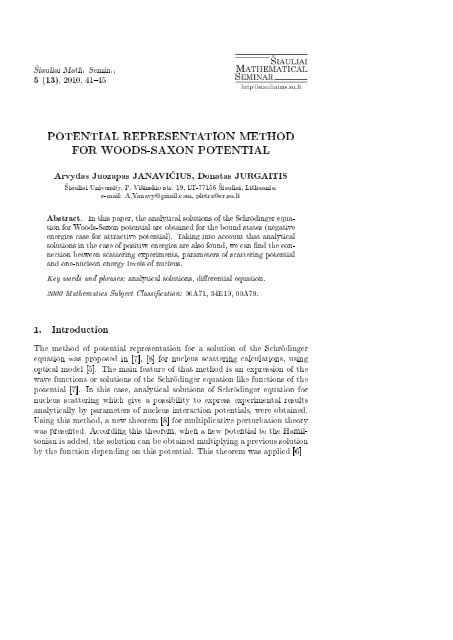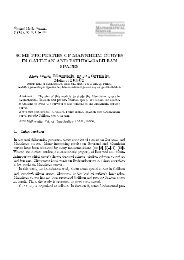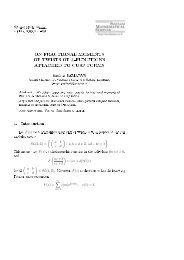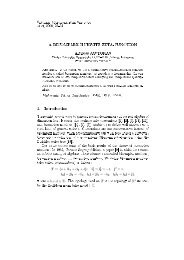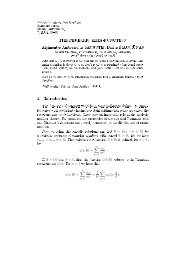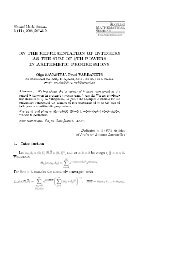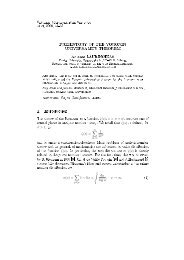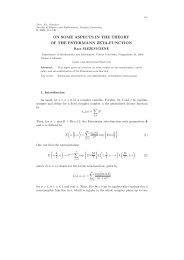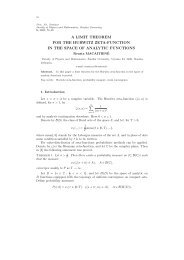POTENTIAL REPRESENTATION METHOD FOR WOODS-SAXON ...
POTENTIAL REPRESENTATION METHOD FOR WOODS-SAXON ...
POTENTIAL REPRESENTATION METHOD FOR WOODS-SAXON ...
Create successful ePaper yourself
Turn your PDF publications into a flip-book with our unique Google optimized e-Paper software.
’iauliai Math. Semin.,5 (13), 2010, 4145<strong>POTENTIAL</strong> <strong>REPRESENTATION</strong> <strong>METHOD</strong><strong>FOR</strong> <strong>WOODS</strong>-<strong>SAXON</strong> <strong>POTENTIAL</strong>Arvydas Juozapas JANAVIƒIUS, Donatas JURGAITIS’iauliai University, P. Vi²inskio str. 19, LT-77156 ’iauliai, Lithuania;e-mail: A.Yanavy@gmail.com, pletra@cr.su.ltAbstract. In this paper, the analytical solutions of the Schrödinger equationfor Woods-Saxon potential are obtained for the bound states (negativeenergies case for attractive potential). Taking into account that analyticalsolutions in the case of positive energies are also found, we can nd the connectionbetween scattering experiments, parameters of scattering potentialand one-nucleon energy levels of nucleus.Key words and phrases: analytical solutions, dierential equation.2000 Mathematics Subject Classication: 00A71, 34E10, 00A79.1. IntroductionThe method of potential representation for a solution of the Schrödingerequation was proposed in [7], [8] for nucleus scattering calculations, usingoptical model [5]. The main feature of that method is an expression of thewave functions or solutions of the Schrödinger equation like functions of thepotential [7]. In this case, analytical solutions of Schrödinger equation fornucleus scattering which give a possibility to express experimental resultsanalytically by parameters of nucleus interaction potentials, were obtained.Using this method, a new theorem [8] for multiplicative perturbation theorywas presented. According this theorem, when a new potential to the Hamiltonianis added, the solution can be obtained multiplying a previous solutionby the function depending on this potential. This theorem was applied [6]
42 A. J. Janavi£ius, D. Jurgaitisfor the Coulomb and short range potentials, using a modied method ofundetermined Lagrange coecients [4]. The presented theory can be used fora wide class of potentials, but in our investigations we mostly apply Woods-Saxon potential which is very useful for nuclear reactions rates calculationsin reactors, and for investigation of astrophysical phenomenon [1].In [7], we presented the analytical solution u(r) of the radial Schrödingerequationd 2 (udr 2 + k 2 L(L + 1)−r 2V (r) =V 0(1 + exp{ r−Ra)− cV (r) u = 0, k 2 = cE, c = 2m 2 ,}) (1)for the Woods-Saxon potential V (r) with potential parameters V 0 , a, R, wherem is a mass of nucleon (proton or nucleon). Using the Woods-Saxon potentialV (r) instead of a variable and substituting u(r) = φ(V (r)) exp{∓ikr}into (1), we obtain, for the case L = 0, the following dierential equationV Vd2 d 2 φ(±k, V )dV 2 + (Vd 2 + V d(V ∓ 2ikaV 0 )) dφ(±k, V )dV−ca 2 V0 2 φ(±k, V ) = 0, V d = V (r) − V 0 . (2)Note that in quantum mechanics scattered waves with orbital quantum numberL = 0 are called s-waves. Assuming that a solution of (2) satises thestandard boundary condition [7]we can express it in the following waylim φ(±k, V ) = 1, (3)r→∞φ(±k, V ) =∞∑V n d n . (4)n=0After substituting (4) into (2), the following recursion relationd n+1 = (ca2 V0 2 + n(2n + 1 ± 2ika)V 0)d n (±k, V ) − (n − 1)nd n−1(n + 1)(n + 1 ± 2ika)V 20was obtained [7]. The solution (4) satises the boundary condition (3) whend 0 = 1, and can dene the useful expression of scattering matrixS(k) L=0 = φ(+k, V p)φ(−k, V p ) ,lim V (r) = V p, (5)r→0
Potential representation method for Woods-Saxon potential 43by which we dene scattering cross sections [7], or scattering probabilities[8] of the colliding nucleus. The solutions (4) expressed by Taylor's series,according to the Poisson integral representation [2], converge and exist in theregion 0 V (r) V p . The calculated values of scattering matrix for scatteringof neutron from dierent nuclei in a wide range of energies were compared[7], [8] with optical model [7] of the program Local Optical Program withAutomatical Parameters Search (F. G. Perey, Krakow Computing Center,1978) results. This program was used for analysis of scattering experiments,and very good coincidences have been obtained. But the presented analyticalsolution [6] and the expression of scattering matrix (5) was obtained only fors-waves when L = 0.2. Analytical solution for bound statesWe shall consider solutions of the radial Schrödinger equation (1) for Woods-Saxon potential for negative discrete energies E < 0 (proper values or eigenvalues)with L = 0, 1, 2, . . . by changing k 2 in equation (1) by −k 2 . Theeigenfunctions of equation (1) of bound states with discrete energies E < 0,representing a particle (one nucleon) located in the denite region, mustsatisfy the following boundary conditionslim u(r) = 0, limr→0and must be represented by [9]u(r) = 0,r→∞u(r) = r L+1 exp{−kr}w(r). (6)Substituting (6) into equation (1) and using a new variabley = r a = R ( )a + log V0V (r) − 1 ,we obtain the dierential equation(F (y) y d2 w(y)dy 2 + 2(L + 1 − kay) dw(y)dy−cV 0 a 2 yw(y) { = 0,F (y) = 1 + exp − R a)− 2ka(L + 1)w(y)}exp{y}. (7)The last dierential equation is obtained by using the fact that, for boundstates E < 0, and substituting (6) into (1). From the obtained equationd 2 w(r)dr 2+ 2(L + 1 − kr) dw(r)dr− (2(L + 1)k + crV (r))W (r) = 0,
44 A. J. Janavi£ius, D. Jurgaitisintroducing the variable y instead of r, we obtain equation (7).We can represent the solution w(y) by power seriesw(y) =∞∑b n y n , (8)n=0which must be terminated [9] at some nite maximum power N. Only inthis case, eigenfunctions which exist in the region 0 y ∞ can be found.Substituting the last expression in equation (7) and expanding in thepower series (7), after equating to zero coecients of y n , we obtain the recurrentrelationse 0 n(n + 2L + 1)b n =n = 0, 1, 2, . . . , N, whereF (y) =N∑e m y m ,m=0n−1∑m=02ak(m + 2k + 2)e n−m−1 b m + cV 0 a 2 b n−2 , (9){e 0 = 1 + exp − R }a, e m = exp { − R am!}, (10)m = 1, 2, . . . , N. Taking in the care that in equation (9) must be b −1 = 0,b −2 = 0, we obtain that the power series begins from constant term b 0 . Nowall expansion coecients for solution (8) can be obtained from (9), (10). Forgetting eigenfunctions (6) from the power series (8), they must be abbreviated,and the coecients b N , for freely chosen N = 2, 3, 4 . . ., must be equalzero. In this case, we transform solution (6) to eigenfunctions u NL (r) witheigenvalues E NL dened by the quantum numbers N, L. However, calculationof eigenvalues k 2 by terminating of power series (8) at some nite maximumpower [9] in analytical form from recurrent relations (9) is complicated, andsome additional investigations must be provided.3. ConclusionsIn this paper, the analytical expressions of eigenfunctions (8) for Woods-Saxon potential are obtained using potential representation method. In thiscase, eigenfunctions can be expressed by potential and are represented bypolynomials with coecients satisfying presented recurrent relations. Weshowed that a potential representation method for positive energies and negativeenergies essentially diers. The analytical expressions of wave functionsu(r) = φ(V (r)) exp{∓ikr}, for any positive energy E > 0 and for L = 0,
Potential representation method for Woods-Saxon potential 45are presented like analytical solution [7] by expanding in the power seriesthe interaction potential V (r). Solutions (4) and (8) satisfy the standardboundary conditions [9] of the Schrödinger equation and, represent the wavefunctions by the interaction potential.Improvements of possibility to get the analytical solutions of the Schrödingerequation with Woods-Saxon potential in common case is presented in[3].References[1] C. A. Bertulani, A potential model tool for direct capture reactions, ComputerPhysics Communic., 156, 123141 (2003).[2] Ph. Dennery, A. Krzywicki, Mathematics for Physicists, Dover Publications,Inc., Mineola, New York, 1996.[3] Jian-You Guo, Zong-Qiang Sheng, Solution of Dirac equation for the Woods-Saxon potential with spin and psiaudospin symmetry, Physics Letters A, 338,9096 (2005).[4] R. S. Guter, A. R. Janpolski, Dierential Equations, High School, Moscow,1976 (in Russian).[5] P. E. Hodgson, Optical model of elastic scattering, Atomizdat, Moscow, 1966(in Russian).[6] A. J. Janavi£ius, D. Jurgaitis, Separation of the scattering matrix with shortrange potential from the background Coulomb eld, Lith. Physical Collect.,26, 273278 (1986) (in Russian).[7] A. J. Janawiczius, K. Kwiatkowski, Schrödinger's equation in potential representationfor Saxon-Wood's potential for the case of s-wave, Report No.1001/PL, Institute of Physics Jagellonian University, Institute of NuclearPhysics, Krakow, 1978 (in Russian).[8] A. J. Janawiczius, R. Planeta, General solution of Schrodinger equation in potentialrepresentation, Report No. 1018/PL, Institute of Physics JagellonianUniversity, Institute of Nuclear Physics, Krakow, 1978 (in Russian).[9] E. Merzbacher, Quantum Mechanics, John Wiley and Sons, New York, 1970.Received23 September 2009


